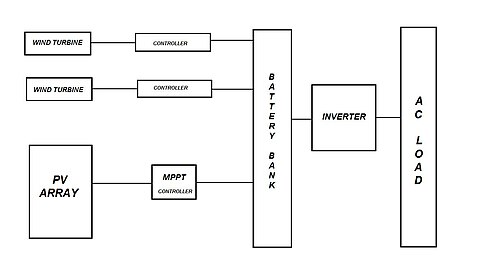Hybrid Renewable Energy System
Biomass-wind-fuel cell
For example, let us consider a load of 100% power supply and there is no renewable system to fulfil this need, so two or more renewable energy system can be combined. For example, 60% from a biomass system, 20% from a wind energy system and the remainder from fuel cells. Thus combining all these renewable energy systems may provide 100% of the power and energy requirements for the load, such as a home or business.
Photovoltaic-wind

Another example of a hybrid energy system might be a photovoltaic array coupled with a wind turbine. This would create more output from the wind turbine during the winter, whereas during the summer, the solar panels would produce their peak output. Hybrid energy systems oftentimes yield greater economic and environmental returns than wind, solar, geothermal or trigeneration stand-alone systems by themselves.
Regulation
To get constant power supply, the output of the renewable may be connected to the rechargeable battery bank and then to the load. If the load is alternating current (AC), then an inverter is used to convert the direct current (DC) supply from the battery to the AC load. Consideration about voltage transition among modules starting from Wind Generator,Battery Charger Controller and Inverter should be subject to voltage standard which mainly focus about voltage compatibility.
Need for research
The key to cost reductions of this order is, of course, the right sort of support for innovation and development - something that has been lacking for the past and, arguably, is still only patchy at present. Research and development efforts in solar, wind, and other renewable energy technologies are required to continue for:
- improving their performance,
- establishing techniques for accurately predicting their output
- reliably integrating them with other conventional generating sources
Economic aspects of these technologies are sufficiently promising to include them in developing power generation capacity for developing countries.